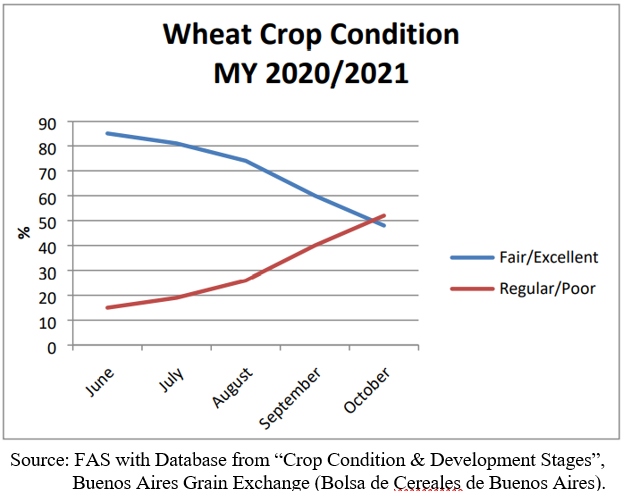
The weather woes afflicting Argentina’s cropping regions this year have been extensive and look set to worsen in December with the La Niña phenomenon running at its strongest level in almost a decade. Many areas of Argentina have been in a moisture deficit since March, and the spring rains have been very sporadic, seriously impacting winter crop production and the summer crop planting program.
There has been a troubling trend across Argentina this year that is very familiar to Australian farmers. The weather forecasts have not been matching reality, the expected rain has not been turning up for the dance, and the dryer than normal pattern is expected to slow the Argentine summer crop planting program.
The Buenos Aires Grain Exchange (BAGE) reported soybean planting progress jumped in the week to November 19, propelled by scattered rains that brought light relief to key drought-hit regions. BAGE estimates that 28.8 per cent of a total projected soybean area of 17.2 million hectares has been sown thus far, up from 19.9 per cent planted a week earlier but still 2.5 percentage points behind last year’s pace.
Conversely, the seeding of this season’s corn crop has stalled, due to both the extremely dry seedbed and a reluctance to plant during November to avoid flowering in the peak of summer. Moisture permitting, seeding will resume in earnest in December with the total planted area forecast to reach 6.3 million hectares this season, down from 6.5 million hectares in 2019/20.
However, many parts of the country remain woefully dry, and it is believed that some of the early sown row-crop fields in the driest regions will have to be replanted when soil moisture levels improve sufficiently.
BAGE called the corn crop 31.4 per cent planted as of November 19. This was virtually unchanged from 31.2 per cent a week earlier but well behind last year’s pace of 46 per cent. The corn area planted to date is rated 10 per cent poor, 55 per cent fair, and 35 per cent good to excellent, but a moisture top-up is urgently required.
The first phase of corn planting in Argentina typically sees around 45 to 50 per cent of the crop planted by early November. With less than a third of the crop now in the ground, what will farmers do come December? Will they continue with their original corn area intentions and plant more of the lower-yielding late crop? Or will they swing some corn area across to soybeans?
It seems several local analysts are expecting the latter, which places a downward bias on corn production estimates and an upward bias on soybean production estimates, assuming the planting rains arrive in time to complete the seeding campaign. However, corn does have a later planting window than soybeans, so if November and December remain dry, and widescale planting doesn’t resume until January, it could easily swing the other way.
In terms of production estimates, the United States Department of Agriculture pegged the Argentinian soybean and corn crops at 51 and 50 million metric tonne (mmt) respectively. The BAGE estimates are a little more conservative, currently running at 47mmt for soybeans and 46.5mmt for corn.
Meanwhile, the winter crop harvest is progressing slowly, and early yields are abysmal as a result of the extremely dry growing season, particularly in the northern provinces.
As of Thursday last week, 19.8 per cent of the forecast wheat area had been harvested, up from 15.5 per cent a week earlier. The yields improved slightly week-on-week from an average of 1 metric tonne per hectare (mt/ha) to 1.2mt/ha.
However, with a planted area of 6.5million hectares, there needs to be a dramatic recovery in yields if final production is going to get remotely close to the BAGE production estimate of 16.8mmt, let alone the USDA’s 18mmt forecast. In fact, the balance of the harvest will need to average almost 3mt/ha just to make the BAGE number.

The wheat crop is currently rated at 17 per cent good to excellent, 40 per cent fair and 43 per cent poor to very poor. The deteriorating state of the crop throughout the growing season is clearly evident in the ‘Wheat Crop Condition’ graphic (above).
The Argentine barley crop has largely escaped the effects of the drought as it is mainly planted in Buenos Aires province and the eastern reaches of La Pampa province. Soil moisture levels have been quite favourable during the season which may well lead to higher than average yields if the kind conditions continue through to harvest. Smaller production areas further north in Cordoba and Santa Fe provinces are, like the wheat, in generally poor condition.
The Buenos Aires Grain Exchange is calling barley production 3.7mmt, slightly higher than the latest USDA number of 3.5mmt. This is down from 3.8mmt last year, but that output was off a significantly higher planted area.
A smaller wheat crop means export offerings out of Argentina will be vastly reduced in the 2020/21 season. And at current prices, it is hard to see the Republic finding much demand outside of the Mercosur region. China is reported to have been purchasing barley of different qualities, including FAQ (fair average quality) which is used for malting. But other than China, barley export sales outside Mercosur block members will also be minimal.
Argentina has been a persistent seller into Asian markets in recent years, in the search for new demand for its burgeoning exportable surpluses. But the smaller crop and higher prices virtually eliminate them as a competitor in the 2020/21 marketing season. That leaves Australia as the sole aggressive seller into Asia at the moment.
Call your local Grain Brokers Australia representative on 1300 946 544 to discuss your grain marketing needs.





